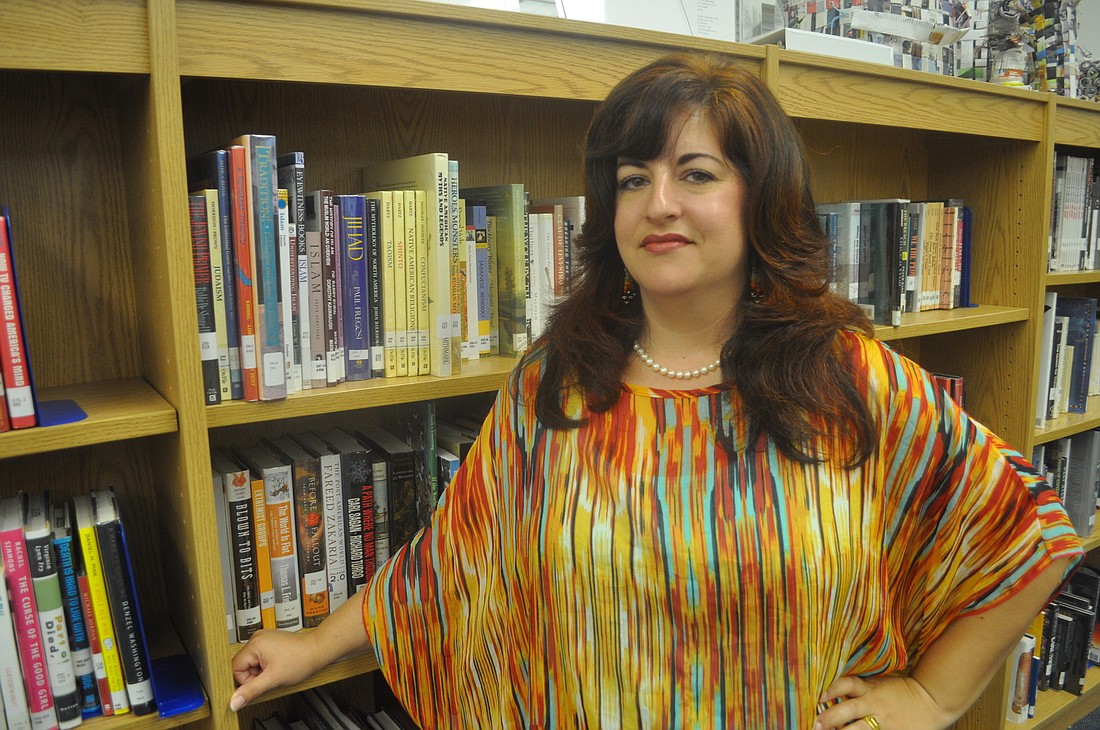- April 15, 2024
-
-
Loading

Loading

LAKEWOOD RANCH — As the librarian at The Out-of-Door-Academy’s Upper School, Alyssa Mandel spends her days dealing in facts.
She researches, files and circulates roughly 6,000 volumes of books and periodicals.
In her other role at the school, as an art-history teacher, Mandel disseminates facts to students.
But, for a woman who craves truth in information — a librarian, who, on the surface is as bookish and rule-abiding as her job requires — Mandel lives her life cloaked in mystery.
For one thing, she once kept her now 18-year belly-dance hobby private from school officials; she saved her secret until she donned a black dress and shimmied across the stage at ODA’s talent show in 2009.
And, now, in her latest job in a varied career that has also included work in jewelry repair and freelance writing, Mandel solves mysteries.
She does it from behind a computer screen, without ever knowing the identity of her client.
Since May, Mandel has worked as an art detective for Art Experts Inc., an art-authentication and appraisal company based in Daytona Beach, with active detectives across the world, including in Uruguay, Argentina and Turkey.
It’s a private top-secret job the notoriously social, media-savvy Mandel won’t even talk about on Facebook.
Mandel’s father calls daily, poking for any clues and to hear the status of the latest mystery.
Through the Internet, in a job that pays by the hour, Mandel determines if a person’s art is real or not.
Although Mandel is good with her hands — she can bake and cook — the art-history buff, with two master’s degrees, never touches the art.
The murky process begins when an owner in possession of a piece of art — a painting or a sculpture, for example — submits a photo of it to the company in-person or through email.
Mandel’s job is strictly telecommunication.
The owner also will include any information he might know about the art, for which he seeks to obtain a certificate of authenticity.
In short, proving the art is an original allows it to be properly valued.
Authentic art is worth more money.
“This work is very exciting,” Mandel said. “It uses all of the skills I’ve been trained for. And, I like solving a good mystery. I like getting the answer, and here I am getting answers about things I love most in the world.”
Mandel obtains the answers using connoisseurship, a skill she learned in school.
In art, connoisseurship means to know almost instinctively who painted a picture.
It’s about knowing the hand of the artist at work.
Once Mandel discovers the creator of the art, which she does by studying brushstroke patterns and signatures, among other things, her focus becomes narrower and her research tighter.
As an example, Mandel recently ruled on an alleged painting by Vincent van Gogh.
The client believed he/she possessed an original of van Gogh’s “L’Arlesienne,” translated to “the woman from Arles,” a group of six similar paintings painted in the late 1800s.
From her research, which consisted of exhaustive searches in books inside Ringling Museum’s library on weekends and evenings, Mandel learned that one of the six paintings had been destroyed.
The client’s painting didn’t look like the other five still in existence, though it was signed “Vincent.”
In a report attached with a bibliography she wrote and submitted via Dropbox to her supervisor at Art Experts, Mandel ruled the client’s painting a fake.
Van Gogh used characteristic brush strokes — rhythmic, repetitive and patterned strokes.
The client’s painting — also knocked for having water stains and custom stamps — did not fit.
Other giveaway characteristics of unauthentic art include bubbles, dirt and cracks.
Mandel never finds out if her supervisor accepts her ruling, though she assumes he does ; he keeps assigning her work.
As of July 3, Mandel has deemed four of the five art pieces she has ruled on as fake.
“The analysis of these things can be somewhat subjective, but I treat it like a logic problem,” Mandel said. “I am looking for facts. If you are about to tell someone they do not possess a $40 million painting, you better be sure.”
Mandel always has been sure in guiding her life path, belying its mishmash nature.
As a teen in Ohio, Mandel wanted to be a librarian, but she waited until her 30s to get a degree.
She gravitated toward teaching, moving in 2001 with her husband, Brian Gomien, an illustrator, to Sarasota to teach at Ringling College of Art and Design.
She taught adjunct but sought something more stable.
She belly danced at cafés with her husband’s band.
Since 2008, she’s been ODA Upper School’s librarian.
Mandel became an art detective when she found a posting for the job on Craigslist, because she sought something more to keep her busy.
“I do meaningful work,” Mandel said. “And there is nothing more meaningful than this.”
Contact Josh Siegel at [email protected].